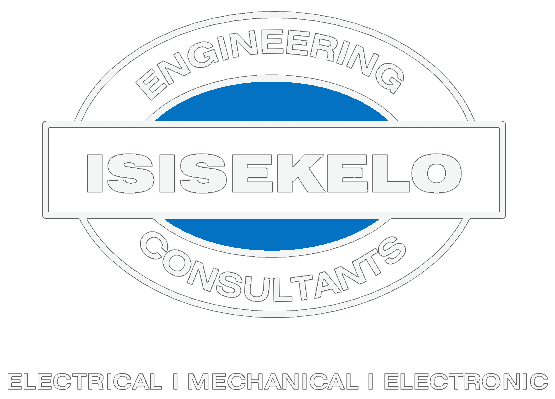We are ready to provide state of the art, innovative and sustainable engineering solutions for you. Allow us to implement environmentally friendly and energy efficient methodologies in engineering design to meet your needs.
Dlanubeka Building, 6th Floor, Office 603, Mbabane, Eswatini
info@isisekeloconsulting.co.za
Monday - Friday (08.00 AM - 05.00PM) Saturday - Sunday (Closed)

Don’t hesitate to contact us for more information about company or services

Copyright © 2022 | Isisekelo Engineering Consultants | All rights reserved.
Detailed cost estimates are prepared at the outset of any project to determine feasibility. All estimates are based on current market-related costs and projections.
The electrical requirements of a site are carefully calculated based on occupation, market sector and usage.
The electrical usage of a site is investigated and strategies for optimisation are adopted.
The choice of electrical tariff can dramatically affect the connection fee paid by the developer. Correct choice can also minimise the cost of electricity consumed. We advise clients on the best cost-effective choice available.
Design of 11kV reticulation and specification of switchgear, transformers and mini-subs.
Design and specification of the low voltage electrical network installed throughout a facility or building to limit losses and provide user comfort.
The inclusion of generators and uninterruptible power supplies (UPS) into current electrical building designs has become necessary for installations where maintaining up-time in the event of power failure is crucial. Isisekelo is responsible for the correct sizing, specification and integration of generators and UPS, which provide emergency power and, depending on the topology, line regulation to connected equipment by supplying power from a dedicated source when utility power is not available.
Design and specification of solar PV system to suit client energy demands. We further provide advice on integrating the solar PV system to the existing electrical infrastructure.
The costs of lighting depend on the levels of lighting required, the energy efficiency of light sources, the degree of daylight present, aesthetic appearance of the fittings, and the mood required in the space. With detailed analysis of various lighting alternatives, including the running costs, we can help our clients choose the most cost-effective solutions that can achieve the client’s desired lighting or illumination effect.
Design and specification of lightning protection systems is crucial to lessen damage to structures by lightning strikes. Good earthing is essential to serve as an adequate zero-voltage reference level for the entire electrical system in a building.
Based on the clients’ metering data, we determine if there is a need for power factor correction, and if there is a need, the required compensation is determined which is necessary for power factor correction.
Design of a structured cabling backbone provides a facility or building based infrastructure that allows the neat and accessible reticulation of all data and telephony points required.
The provision of fire detection and alarm systems is mandatory in terms of the building codes. We advise when systems are required, as well as the extent and type of system which would provide the most cost-effective solution.
Closed-circuit television (CCTV) can be designed to monitor specific areas or an entire facility.
We can advise clients on the most effective, workable and convenient access control systems that can be included in a building design to manage personnel movement and physical resources. The use of proximity and active cards makes the system convenient and flexible, and can be integrated with the CCTV system to provide video records of events.
Public address systems incorporate verbal or electronic announcements as well as distribution of background music. We design the whole system and then select appropriate speakers, control equipment and amplifiers.
We design various heating, ventilation and air- conditioning (HVAC) systems. Since various options exist with regard to the types of HVAC systems chosen; before undertaking any design work, we first explore various several choices and present the client with the cost, performance, maintenance, and life cycle costs of these options.
We design and provide advice to clients on the most effective, workable and convenient kitchen ventilation systems that can be integrated into the overall building HVAC system to ensure efficient extraction of fumes from the kitchen space produced by cookware; and supply of replacement air into the kitchen space.
We perform lift traffic and escalator traffic analyses to determine the most cost-effective solutions to vertical transportation.
We undertake the full design, site supervision and budget control for the various plumbing and drainage installations required in the building. These designs incorporate the water authority connections, reticulation and final fix appliances and include the following:
We determine the most suitable method of providing cold and hot water to the building. Cold water supply from the is assessed in terms of the building's requirements, SABS 10252-1 and local water authority requirements, i.e. the supply is assessed in terms of flow of pressure for the expected demand. The size of the required cold water connection is determined and metering requirements coordinated with the water authority.
Drainage is designed to comply with the SABS 10252-2 and local water authority requirements. Connection into the water authority’s sewer is coordinated directly with their representatives. All drainage systems are designed to ensure adequate venting, anti-siphoning and access for rodding purposes.
Suitable down pipes guttering systems, full-bores and drains are designed to drain rain water from building roofing. The connection to the local water authority’s storm water drain is coordinated with them.
We assist the Architect where requested in the selection of suitable sanitary ware for each application. Pressure and flow requirements for the sanitary ware selected for each project are assessed to ensure that the system will operate satisfactorily.
This involves the assessment of the entire development for compliance with the statutory requirements of SABS 0400. With our knowledge of fire design, we take all necessary factors into consideration. All documentation is submitted to the local fire authority for approval.
We design powered smoke extraction and natural smoke ventilation systems; and powered staircase and lift pressurisation systems to achieve the requirements of the SABS 0400 and local fire authority requirements. All designs are submitted to the local fire authority for approval.
We provide complete designs for the fire protection systems from water supply and storage requirements to the sprinkler head layouts. In addition, fire hose reel, extinguisher and hydrant design is taken from water supply stage to final fitting. These designs conform to the statutory requirements and include investigations into flow and pressure performance of existing water supplies. Flow and pressure tests are conducted on all fire protection equipment designed by us to ensure that the final product will operate correctly when required to do so.
We produce full fire and escape signage drawing layouts in accordance with the statutory requirements. Representations are made to council on behalf of client and architect where alternative signage is desired for aesthetic considerations. By incorporating the signage into the emergency lighting layout, waivers can be sought for size and type of signage.
Building management and automation are control systems designed to monitor and control the mechanical and electrical systems in a building to reduce building energy and maintenance costs when compared to a non- controlled building. Isisekelo can assist in the complete integration of these systems into a new or existing installation
In depth inspections and analysis of existing facilities reveal much of how their power is managed and consumed. Energy audits are undertaken to drive down operating costs by implementing new energy management strategies and efficient equipment.